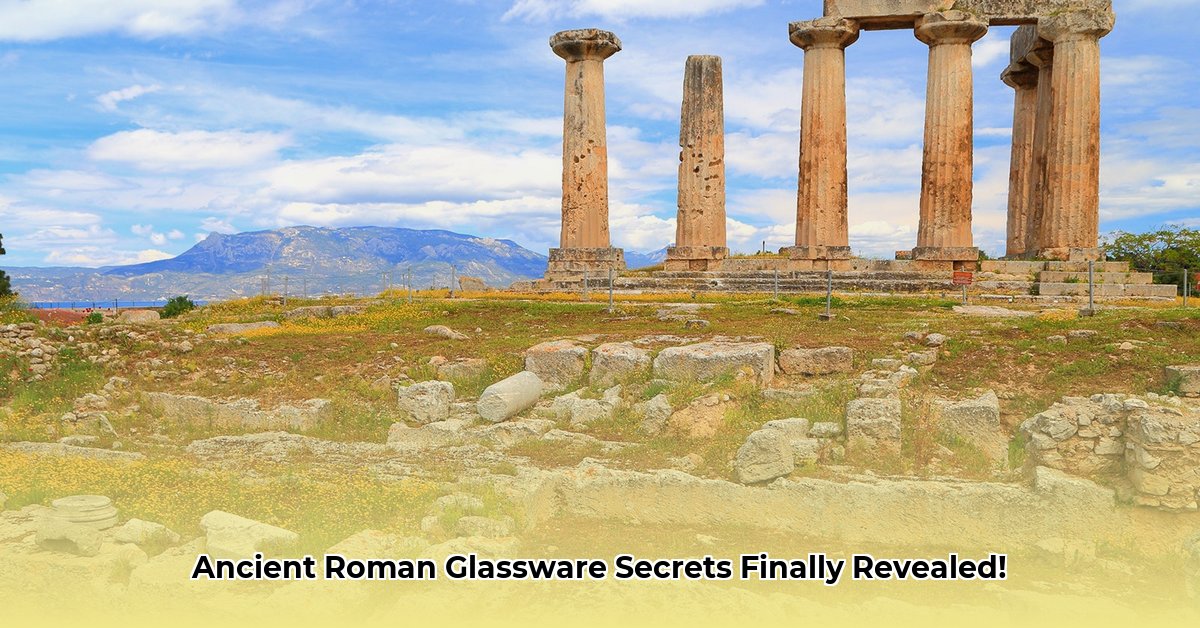Have you ever gazed upon a fragment of ancient glass, shimmering with an ethereal iridescence, and wondered about the hands that shaped it two millennia ago? The saga of ancient Roman glassware transcends mere artistry; it is a captivating narrative of human innovation, scientific understanding, and profound societal transformation. Far from being a niche luxury accessible only to the elite, glass in the Roman world evolved into an ubiquitous material, a testament to ingenious production methods that propelled it from obscurity to an indispensable component of daily life. Join us as we delve into the sophisticated techniques, intricate chemistry, and widespread influence that defined this remarkable era of glassmaking. Learn more about Roman glass artifacts from expert sources.
The Glass Revolution: From Precious Art to Pervasive Utility
Before the formidable Roman Empire extended its vast dominion, glass remained an exotic rarity. Imagine small, often opaque vessels, painstakingly crafted in distant Mesopotamian and Egyptian workshops, reserved exclusively for the most privileged. However, the Roman era, particularly from the 1st century BCE onwards, marked a pivotal shift. This period heralded the birth and widespread adoption of glassblowing technology, a revolutionary innovation that fundamentally reshaped the destiny of glass, embedding it deeply within the fabric of Roman daily life, culture, and economy.
The advent of glassblowing, likely originating in the Syro-Palestinian region, was nothing short of a game-changer. Artisans discovered that by inflating a gather of molten glass on the end of a hollow iron rod, they could rapidly produce vessels with significantly thinner walls and greater translucency. This ingenious method dramatically reduced the amount of raw material required and accelerated manufacturing to unprecedented levels. The economic impact was immediate and profound; the ancient geographer Strabo, in his Geographica (XVI.2), famously recounted that a glass drinking cup could be acquired for as little as a single copper coin by the mid-1st century CE, powerfully underscoring its newfound accessibility. While Roman glassblowing surged in popularity, older methods such as core-forming and casting continued to be employed, particularly for the creation of more substantial, luxurious, or intricately decorated pieces, showcasing the dual nature of production that catered to both mass markets and elite tastes. This dual approach meant that by the peak of the Roman glass industry in the 2nd century CE, an estimated 100 million items of glassware were being produced annually, a scale of production largely unmatched until the Venetian glass boom of the 15th century.
The Alchemist’s Secret: Decoding Roman Glass Chemistry
The captivating allure of Roman glass, with its spectrum of colors and eventual pursuit of crystalline clarity, lay in a sophisticated understanding of raw materials and chemical additives. Roman glassmakers primarily relied on fusing two core ingredients: silica (sand) as the former, and soda as the flux. Analysis of Roman glass artifacts has consistently shown sodium carbonate (soda) to be the exclusive flux, derived predominantly from natron, a naturally occurring salt found in dry lake beds. The main source of this vital natron during the Roman period was Wadi El Natrun in Egypt, although there may have been minor local sources in Italy.
To prevent the glass from becoming water-soluble, a stabilizer—primarily lime—was crucial. While not added as a separate component, lime naturally entered the glass mixture through calcareous particles present in the beach sand used as the silica source. Roman glass also uniquely contained around 1% to 2% chlorine, believed to originate either from the deliberate addition of salt (NaCl) to reduce melting temperature and viscosity, or as a natural contaminant within the natron itself.
The ability of Roman artisans to manipulate color was a testament to their refined ancient craftsmanship and chemical knowledge. By judiciously adding various metallic oxides and controlling furnace conditions, they conjured a vibrant palette:
| Colourant | Content | Comments | Furnace Conditions |
|---|---|---|---|
| ‘Aqua’ (Pale Blue-Green) | Iron(II) oxide (FeO) | This is the common, natural hue of untreated glass, resulting from naturally occurring iron impurities in the sand. Many early Roman vessels exhibited this subtle coloration. | Natural |
| Colourless | Iron(III) oxide (Fe₂O₃) | Achieving true colourless glass was a significant technical feat. Roman glassmakers decolorized glass by adding either antimony (like stibnite) or manganese oxide (like pyrolusite). These compounds oxidized the iron(II) oxide to iron(III) oxide, which, despite being a weaker yellow colorant, allowed the glass to appear clear. The use of manganese as a decolourant was a Roman invention, first noted in the Imperial period. Antimony, however, acted as a stronger decolourant, producing a more truly colourless glass. In Italy and northern Europe, antimony or a mixture of antimony and manganese continued to be used well into the 3rd century. | Oxidizing |
| Amber | Iron–sulfur compounds | Sulfur, likely introduced as a contaminant in the natron, could produce a green tinge. The formation of specific iron-sulfur compounds within the glass matrix resulted in desirable amber tones. | Reducing |
| Purple | Manganese (approx. 3%) | Adding manganese, often in the form of pyrolusite, to the glass melt under oxidizing conditions produced rich purple and amethyst shades. | Oxidizing |
| Blue and Green (Intensified) | Copper (2%–13%) | The natural ‘aqua’ shade could be intensified, or distinct blue/green hues achieved, by adding copper. This was often derived from the recovery of oxide scale from scrap copper when heated, carefully avoiding contaminants in copper minerals. Copper produced translucent blues moving towards darker, denser greens depending on concentration and furnace conditions. | Oxidizing |
| Dark Green | Lead | By adding lead to copper-infused glass, the green coloration could be deepened significantly, creating a rich, opaque dark green. | Varies |
| Royal Blue to Navy | Cobalt (0.1%) | Even trace amounts of cobalt could produce remarkably intense and vibrant royal blue to navy hues, demonstrating the potent coloring power of this element. | Varies |
| Powder Blue | Egyptian Blue | This specific pigment, a synthetic calcium copper silicate known as Egyptian Blue, was sometimes incorporated to produce a distinct powder blue. | Varies |
| Opaque Red to Brown (Haematinum) | Copper (>10% Cu), Lead (1%–20% Pb) | Under strongly reducing furnace conditions, copper present in the glass would precipitate within the matrix as cuprous oxide, yielding a striking opaque brown to blood-red appearance, known to Pliny as haematinum. Lead encouraged this precipitation and enhanced the brilliance of the color. This red glass, though rare, was produced from the 4th century onwards. | Strongly Reducing |
| White (Opaque) | Antimony (1–10%) | Antimony, often from stibnite, reacted with the lime in the glass matrix to precipitate calcium antimonite crystals, creating a highly opaque white. This was particularly effective for decorative elements. | Oxidizing |
| Yellow (Opaque) | Antimony and Lead | The precipitation of lead pyroantimonate resulted in an opaque yellow. This color rarely appeared alone in Roman glass but was frequently employed in complex mosaic and polychrome pieces. | Varies |
These colorants, despite requiring considerable technical knowledge and precise control over furnace conditions, formed the basis of virtually all Roman glass production, enabling a remarkable degree of uniformity across the empire’s vast workshops. Chemical analyses of artifacts also reveal subtle regional differences, with Western Roman glass typically containing around 3% alumina, while Eastern counterparts exhibited notably lower percentages, hinting at variations in sand sources.
Beyond the Blowpipe: Masterful Roman Glass Techniques
While glassblowing redefined efficiency, Roman artisans excelled in a myriad of other sophisticated techniques, elevating glass from mere utility to high art. Their mastery extended far beyond simple inflation, demonstrating unparalleled skill and creativity:
- Core-Forming: An ancient technique, popular in the early Republican period, where a core of mud and straw was built around a metal rod. This core was then dipped into molten glass or trailed with liquid glass. After cooling, the core was removed, and handles, rims, and bases were added. These vessels were typically thick-walled, brightly colored, and often featured zigzag patterns, generally limited to small unguent or scent containers.
- Casting (Slumping): Pouring molten glass into molds or slumping heated glass sheets over forms allowed for the creation of thicker, heavier, and more intricately shaped items. This method was often favored for high-end tableware, decorative panels, and large dishes, providing the necessary thickness for later cutting and polishing.
- Millefiori and Mosaic Glass: This captivating “thousand flowers” technique involved fusing bundles of colorful glass rods, cut in cross-section, to create intricate mosaic-like patterns embedded within the glass. Similarly, ‘mosaic’ glass could be formed by fusing plain or multicoloured glass shards, or even pre-formed spiral and marbled patterns, which were then slumped into desired shapes, often imitating natural stones like sardonyx.
- Cameo Glass: Perhaps one of the most celebrated and labor-intensive methods, cameo glass involved layering different colored glass (typically opaque white over a darker ground) and then meticulously carving away the upper layers to reveal contrasting designs in relief, often depicting mythological scenes or portraits. The globally renowned Portland Vase, made during the reign of Augustus, stands as a prime example of this exacting technique, showcasing unparalleled artistry and precision.
- Cage Cups (Diatreta): Considered the absolute pinnacle of Roman glass artistry, these extraordinarily complex vessels, dating primarily from the 3rd and 4th centuries CE, featured an intricate, perforated outer cage entirely carved from the same single piece of glass as the inner cup, connected only by delicate, hidden glass struts. Their creation demanded unparalleled skill, immense patience, and advanced abrasive techniques. The Lycurgus Cup, housed in the British Museum, is a famous example, notable for its dichroic glass which contains tiny particles of gold and silver, causing it to change color from red to green when viewed in transmitted versus reflected light – a true marvel of ancient nanotechnology.
- Wheel Engraving and Cutting: Utilizing a spinning wheel fed with abrasives, artisans could cut and engrave intricate designs onto glass surfaces. This ranged from simple linear incisions to complex relief scenes, often mimicking contemporary metalwork or rock crystal carvings. The diatretarii, or glass-cutters, were highly specialized craftsmen.
- Enamelled and Gilt Glass: Pigments mixed with a glassy flux could be fused to the surface of a glass vessel through a separate firing, creating vibrant enamelled designs. Gold leaf was also incorporated, often sandwiched between two fused layers of glass, creating intricate patterns, funerary medallions, or even portraits, particularly popular in the 3rd and 4th centuries CE.
- Applied Decoration: Small pieces or trails of hot glass could be applied to the vessel’s surface before it cooled, creating decorative bosses, textured patterns, or even distinctive serpentine threads (Schlangenfadengläser), a specialty of Rhineland workshops.
The intricate nature of these decorations undeniably required immense skill and time, making these breathtaking artistic results clear demonstrations of the Romans’ unwavering dedication to beauty and technical excellence.
Glass in the Grand Tapestry of Roman Life: Function, Fashion, and Flux
Ancient Roman glassware was far more than a mere decorative accessory; it was intricately woven into the very fabric of Roman life, serving a kaleidoscopic array of functions across all social strata. Everyday household items included durable drinking cups, bowls, plates, and bottles for storing and serving food and drinks. Bottles known as alabastra and unguentaria elegantly stored precious perfumes, oils, and cosmetics used in the morning rituals of fashionable Roman women, while pyxides (boxes) held jewelry and other personal items. Merchants relied on robust glass jars and amphoriskoi to safely transport wine, olive oil, and other essential goods across the vast Roman trade routes, underscoring glass’s non-porous and odorless advantages over pottery. Archaeological discoveries of Roman glass objects as far afield as Japan, Afghanistan, India, and China demonstrate the unparalleled breadth of their global trade networks.
But the versatility of glass extended far beyond simple containers. It revolutionized architecture and interior design, appearing in shimmering mosaics that adorned floors and walls, reflective mirrors, and innovative windowpanes that allowed light to flood into homes, public baths, and commercial buildings. The earliest panes were rough cast into wooden frames, but by the late 3rd century CE, the more refined muff process, involving flattening a blown cylinder, greatly improved quality. Glass even found practical applications in medicine, with powdered glass reportedly used as a medicine and even toothpaste. In the bathhouses, glass strigils were used to scrape off oil. How could a material once considered a rare luxury become so indispensable? This widespread utility underscores the material’s economic and social importance, directly linked to the cost reduction facilitated by advanced glassblowing technology.
Pioneers of Sustainability: The Roman Art of Recycling
In a striking early testament to sustainability, the Romans routinely engaged in the recycling of broken glass, a practice that was not merely an occasional habit but a pervasive and economically rational one. Archaeological evidence strongly supports this, as the relative scarcity of glass fragments, particularly of any significant size, recovered from many domestic sites indicates that glass was too valuable to be discarded. Instead, it was systematically collected, melted down, and repurposed into new vessels. Roman writers of the era, such as Statius and Martial, documented this practice, highlighting an awareness of resource conservation. In the western empire, evidence suggests frequent and extensive recycling, with quantities of broken glassware concentrated at local sites prior to remelting. In the eastern empire, recycled Roman glass was even used to glaze Parthian pottery. Compositionally, repeated recycling is often visible in archaeological fragments via elevated levels of those metals originally used as colourants, confirming their reuse. This commitment to recycling not only maximized resources but also made glass more economically viable for broader segments of society.
Hubs of Innovation: Where Roman Glassmaking Flourished
Glass production in the Roman Empire was not centralized solely in Rome, but rather flourished in dynamic and influential hubs across its vast territories, serving both local demands and extensive export markets. These centers were strategically located near essential raw materials: fuel (wood for kilns), sand (silica), and natron (fluxing agent).
- The Eastern Mediterranean (Syro-Palestinian Region & Egypt): This region, particularly around Alexandria and the Levantine coast, was a cradle of glassmaking, perfecting ancient techniques like mosaic glass and pioneering glassblowing. The reliance on natron from Wadi El Natrun meant that primary glassmaking workshops, which produced raw glass in large tanks (as evidenced by the 8-tonne slab recovered from Bet She’arim), were heavily concentrated in these near-coastal regions. This facilitated the trade in raw, colourless, or naturally coloured glass ‘slag’ throughout the empire.
- Italy: Early glass working sites developed in Rome, Campania, and the Po Valley by the end of the 1st century BCE. Italy became a renowned center for working brightly colored vessels, with production peaking in the mid-1st century CE. Notable luxury items like cameo glass (e.g., the Portland Vase) and magnificent cage cups (diatreta) are often associated with Italian workshops, possibly at Aquileia.
- The Rhineland (e.g., Colonia Claudia Ara Agrippinensium/Cologne): By the Imperial period, centers along trade routes in the Rhineland and northern France became profoundly important glass working sites. Cologne, in particular, grew into a major hub, producing distinctive regional forms not seen further south. The Romano-Germanic Museum in Cologne boasts the world’s largest collection of Roman glass (over 4,000 pieces), including luxury glasses like figure vessels, cut glasses, and the famous Cologne cage cup, as well as typical Cologne nubs (drinking vessels with applied glass drops). This region also developed a significant school of glass engraving and the unique Schlangenfadengläser (snake thread glasses) and Rüsselbecher (claw beakers).
These powerful hubs played a critical role not only in disseminating advanced glassmaking techniques but also in spreading Roman cultural influence across other civilizations, as evidenced by the widespread distribution and uniformity of Roman glassware throughout the empire. Modern archaeological efforts continue to uncover invaluable insights into these ancient workshops, with advancements in chemical analysis techniques increasingly illuminating ancient trade routes and production networks, often revealing a largely homogenous composition due to the common natron source.
The Enduring Luster: Legacy and Allure for Modern Eyes
The innovative methods perfected by Roman glassmakers, particularly the widespread adoption of glassblowing, laid the fundamental groundwork for glass production for centuries to come, profoundly shaping subsequent eras of craftsmanship worldwide. From the intricate chemical understanding that allowed for varied colors and clarity, to the complex artistic techniques that yielded breathtaking works like the cage cups, Roman glass stands as a testament to unparalleled ingenuity.
Today, these remarkable artifacts continue to captivate archaeologists, historians, and collectors alike. They offer tangible, shimmering insights into various facets of Roman daily life, their evolving artistic preferences, and their impressive technological advancements. The sheer artistry, remarkable diversity, and widespread utility of Roman glassware stand as enduring testaments to the creativity and innovation of these ancient artisans, reaffirming the timeless appeal of this extraordinary material.
Perhaps one of the most enchanting qualities of genuine ancient Roman glass, particularly for collectors, is its distinctive iridescence. Over centuries, exposure to the elements and the unique chemical composition of the glass results in a gradual alteration of its surface, causing it to shimmer with a captivating rainbow of colors. This natural patina adds a layer of unparalleled beauty and historical authenticity, a unique testament to its antiquity and its journey through time.
A Collector’s Expedition: Navigating Ancient Roman Glassware
Are you captivated by the idea of owning a tangible piece of this ancient legacy? Venturing into the world of collecting ancient Roman glassware can be a profoundly rewarding endeavor, connecting you directly with the past through these exquisite objects.
Key Features and Considerations
As you begin to build a collection, several features distinguish these artifacts and significantly influence their value and appeal:
- Distinctive Attributes: Familiarize yourself with the typical forms, characteristic colors, and decorative techniques native to Roman glass from different periods and regions. Understanding these specific markers—from the pale aqua greens of early blown vessels to the vibrant millefiori patterns or the intricate cut decoration of later pieces—is crucial for identification.
- Condition: While perfectly intact vessels are highly prized and command premium values, even fragments or pieces with minor damage can hold immense historical and aesthetic significance, especially if they exhibit rare techniques, unique forms, or originate from historically important sites. Collectors often appreciate minor imperfections as part of an artifact’s journey.
- Patina (Iridescence): The development of an iridescent sheen, or patina, on glass that has been buried for centuries is highly valued by collectors. It serves not only as compelling evidence of age but also adds a unique visual beauty. A vibrant, stable patina suggests the object has been well-preserved and not over-handled, which can be a key indicator of quality.
- Rarity: Some forms, colors, or decorative techniques of Roman glass are considerably rarer than others, naturally increasing their value among discerning collectors. Pieces like true cage cups or large, well-preserved cameo glass examples are exceedingly rare and highly sought after.
- Artistic Quality: Pieces exhibiting exceptional craftsmanship, intricate decoration, or particularly beautiful and balanced forms are always highly sought after, reflecting the pinnacle of Roman artistry and commanding higher prices. This includes detailed wheel-cut scenes, expertly applied threads, or complex mold-blown designs.
Ethical Considerations and Authentication
The allure of ancient Roman glassware also brings with it critical ethical considerations, particularly regarding its trade. It is paramount to ensure that any piece you acquire has been obtained legally and ethically, steering clear of artifacts that may have been plundered from archaeological sites. In many regions, governments actively regulate the market to safeguard cultural heritage and combat illicit trade in antiquities.
For aspiring collectors, consulting with accredited experts and demanding clear, verifiable certificates of authenticity are indispensable steps. Understanding the nuances of natural iridescence versus artificial treatments, typical manufacturing imperfections (such as small bubbles or pontil marks from the blowing process), and common forms will also significantly aid in authentication. Reputable dealers will always provide transparent information about an item’s history.
Proven Tactics for Collecting and Preserving
Embarking on this collecting journey requires diligence, informed decision-making, and a commitment to preservation. Here are some proven tactics for collecting and preserving Roman glassware:
| Aspect | Action | Efficacy |
|---|---|---|










